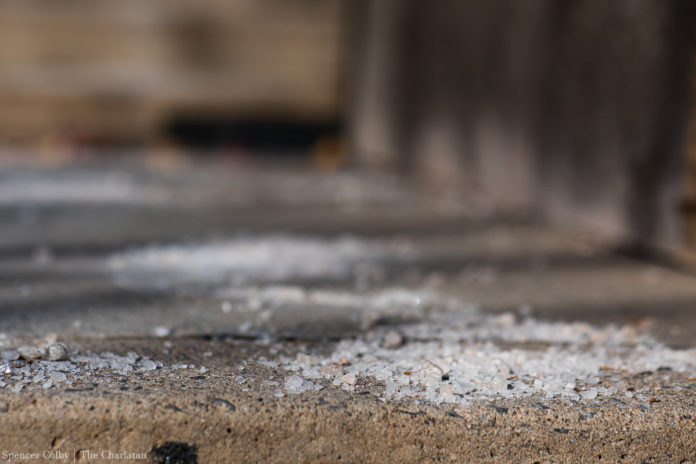In most Canadian cities, the application of road salt to streets, sidewalks, and driveways is a common winter-time practice. We don’t often think twice about buying a few bags of salt for our driveways and walkways—after all, it is the cheapest option (in the short term) for keeping a handle on snow and ice.
However, the long-term effects of urban winter salting can have devastating impacts on the environment. In 2004, Canada actually officially categorized the substance as a toxin.
Countrywide, the average winter sees five million tonnes (over 110 billion pounds) of salt applied across the country. Before we discuss the environmental impacts of salt, take a moment to try to comprehend such mind-bogglingly huge numbers of a harmful, toxic substance being deposited into our environment annually.
The problems with road salting arise not on the roads themselves, but because once it’s deposited, it does not stay put. The whole process of cars passing over the salt—which is what allows for safe traction—causes it to spray and spread further, accumulating on anything and everything near roadways.
You may have noticed the negative impacts of this on your own vehicle, such as corrosion and rusting both caused and exacerbated by road salt.
This also means massive amounts of salt seep into the surrounding environment. Ever since road salting became a widespread practice in North America, the levels of sodium and chloride—the elements road salt is made of—increased 130 and 243 per cent respectively in some bodies of water, including runoff streams, reservoirs, and other sources of water for municipalities. The vast majority of these increases came from road salting sources.
These toxic substances alter the dynamics of these aquatic ecosystems, changing zooplankton species—the tiny organisms that make up the foundation of aquatic food chains—to new salt-tolerant types, which can have consequences that reverberate throughout the food chain.
Contamination 0f ground and freshwater also gives us reason to worry for our own health. Salt leaching into the water cycle was found to pose health threats for folks who require sodium-reduced diets in suburban Boston, Mass., particularly those with hypertension, as not all of the salt can always be perfectly filtered out of the water that comes out of our taps.
Given that almost a quarter of Canadians have hypertension, this is a significant public health risk directly impacted by our road salt habits.
The massive increase to the salt content of soil located next to roads affects roadside vegetation. Salty soil can’t hold as much water as regular soil, which directly impacts plant growth. Reduced plant growth means reduced plant fertility and local extirpation, meaning plants die without regrowing in the area — often one of the first things that leads to extinction. For instance, trees living near roadways can be dehydrated and die due to the intense salt concentration in the soil.
Many invasive plants are well-adapted to high levels of salt in the soil, leading to greater potential for invasive species to take over roadside plant communities and out-compete the surviving native vegetation. This is seriously bad news, as invasive species spread is considered the second greatest cause of biodiversity loss, second only to habitat destruction (which may be exacerbated by human activities, such as salting, or processes such as the spread of invasive vegetation).
For instance, a study in Massachusetts found that road salt use directly aided the spread of invasive species in one of the state’s most important wetland ecosystems. Given that global climate change is already stressing plant life and leading to altered vegetation patterns, this is a massive cause for concern.
Wild animals that require increased salt during spring are attracted to leftover deposits of road salt, posing a danger to themselves and drivers as they seek these deposits at roadsides. These wild salt-seekers include moose, which can cause severe injury, or even death if collided with while driving. Despite a variety of measures to prevent such roadside large wildlife collisions, thousands occur in various provinces each year, which are exacerbated by the mass salt deposits left near highways and roads during the spring.
Critical infrastructure such as water pipes can be corroded by road salt, leading in one instance to a burst pipe in Montreal, which flooded hundreds of homes. So not only does our salt habit degrade the habitat and negatively affect other forms of life in our surrounding ecosystem, but it can directly harm us through its corrosive effects on the urban landscape.
Not all hope is lost, though—seemingly quirky but sustainable alternatives to solely road salt are already being implemented in both Canada and the United States.
Many snowy Canadian municipalities, such as Laval, Calgary, Toronto, and Winnipeg, have begun to use more environmentally-friendly de-icing strategies, such as spraying roads with mixtures that combine beet juice with a small amount of salt. These de-icers not only stay on the road longer, but are actually more effective at colder temperatures.
Why? At the molecular level, beet juice works in the same way as road salt (by lowering the melting point of ice). It can also assist municipalities in saving money in the long run—though specific machinery must be bought and installed to make the transition away from pure salt at first. The need for fewer applications can also save limited municipal funds through reduced frequency of de-icing trucks, along with the resultant side benefit of having to purchase less fossil fuels to run them.
Even better is that beet juice is not the only sustainable move towards winter road safety. Wisconsin is experimenting with a de-icing solution based on a combination of salt and cheese brine, which reduces total salt use by 30 to 40 per cent. These mixtures are similar to beet-based ones: they function well below the temperatures pure road salt can, don’t leave residue, and use industrial byproducts from the dairy industry that would otherwise have been dumped as waste.
All this being said, in a city such as Ottawa which often has dozens of extremely cold days during the winter, swapping to these alternatives may make more than just ecological sense. The municipal government could reduce long-term spending on keeping winter roads safe, as well as reduce the risk of infrastructure degrading due to the corrosive nature of salt.
At home, using a mixture of beet juice—which can be found in many food stores or even in powdered form—with salt can provide the same benefits mentioned above, and is an easy way to instantly begin creating a more sustainable lifestyle while keeping your pavement navigable.
It may take some experimenting, as municipalities varied widely in how much salt has to be added to their more sustainable solutions. However, it is clearer now more than ever that switching to sustainable choices can save much-needed time and energy, both for governments and civilians.
Featured image by Spencer Colby.




![Here’s how your favorite media platforms shape your world view without you realizing it Advertising revenue and subscriptions are the main source of income for news outlets. [Graphic by Sara Mizannojehdehi]](https://charlatan.ca/wp-content/uploads/2021/07/11BE7ADB-1CC8-46E8-ADB4-568B3C7F1265-218x150.jpeg)

